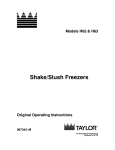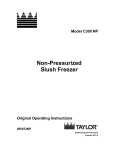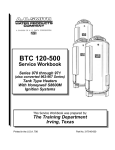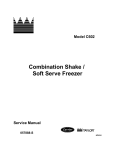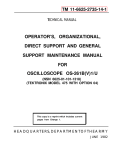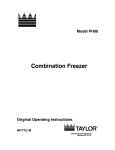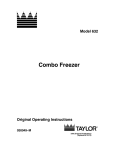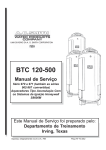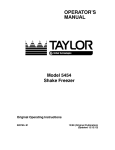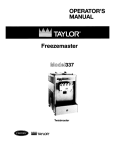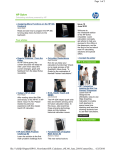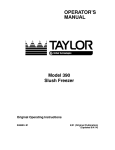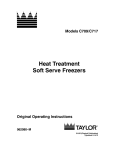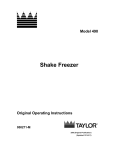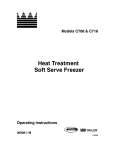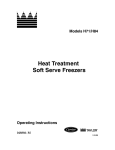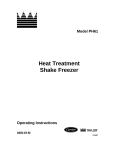Download Taylor Blender 048887-M User's Manual
Transcript
Model H63 Shake Freezer Original Operating Instructions 048887-- M 5/09/02 (Original Publication) (Updated 11/14/11) Complete this page for quick reference when service is required: Taylor Distributor: Address: Phone: Service: Parts: Date of Installation: Information found on the data label: Model Number: Serial Number: Electrical Specs: Voltage Cycle Phase Maximum Fuse Size: A Minimum Wire Ampacity: A E May, 2002 Taylor All rights reserved. 048887--M The word Taylor and the Crown design are registered trademarks in the United States of America and certain other countries. Taylor Company 750 N. Blackhawk Blvd. Rockton, IL 61072 Table of Contents To the Installer . . . . . . . . . . . . . . . . . . . . . . . . . . . . . . . . . . . . . . . . . . . . 1 Installer Safety . . . . . . . . . . . . . . . . . . . . . . . . . . . . . . . . . . . . . . . . . . . . . . . . . . . . . . . . 1 Site Preparation . . . . . . . . . . . . . . . . . . . . . . . . . . . . . . . . . . . . . . . . . . . . . . . . . . . . . . . 1 Air Cooled Units . . . . . . . . . . . . . . . . . . . . . . . . . . . . . . . . . . . . . . . . . . . . . . . . . . . . . . . 2 Water Connections (Water Cooled Units Only) . . . . . . . . . . . . . . . . . . . . . . . . . . . . 2 Electrical Connections . . . . . . . . . . . . . . . . . . . . . . . . . . . . . . . . . . . . . . . . . . . . . . . . . 2 Beater Rotation . . . . . . . . . . . . . . . . . . . . . . . . . . . . . . . . . . . . . . . . . . . . . . . . . . . . . . . 3 Refrigerant . . . . . . . . . . . . . . . . . . . . . . . . . . . . . . . . . . . . . . . . . . . . . . . . . . . . . . . . . . . 3 Section 2 To the Operator . . . . . . . . . . . . . . . . . . . . . . . . . . . . . . . . . . . . . . . . . . . 4 Section 3 Safety . . . . . . . . . . . . . . . . . . . . . . . . . . . . . . . . . . . . . . . . . . . . . . . . . . . . 5 Section 4 Operator Parts Identification . . . . . . . . . . . . . . . . . . . . . . . . . . . . . . . 7 Accessories . . . . . . . . . . . . . . . . . . . . . . . . . . . . . . . . . . . . . . . . . . . . . . . . . . . . . . . . . . 9 Important: To the Operator . . . . . . . . . . . . . . . . . . . . . . . . . . . . . . . . . 10 Symbol Definitions . . . . . . . . . . . . . . . . . . . . . . . . . . . . . . . . . . . . . . . . . . . . . . . . . . . . 10 Power Switch . . . . . . . . . . . . . . . . . . . . . . . . . . . . . . . . . . . . . . . . . . . . . . . . . . . . . . . . . 10 Liquid Crystal Display . . . . . . . . . . . . . . . . . . . . . . . . . . . . . . . . . . . . . . . . . . . . . . . . . . 11 Consistency Control . . . . . . . . . . . . . . . . . . . . . . . . . . . . . . . . . . . . . . . . . . . . . . . . . . . 11 Product Ready Light . . . . . . . . . . . . . . . . . . . . . . . . . . . . . . . . . . . . . . . . . . . . . . . . . . . 11 Reset Mechanism . . . . . . . . . . . . . . . . . . . . . . . . . . . . . . . . . . . . . . . . . . . . . . . . . . . . . 11 Operating Screen Descriptions . . . . . . . . . . . . . . . . . . . . . . . . . . . . . . . . . . . . . . . . . . 11 Operator Menu . . . . . . . . . . . . . . . . . . . . . . . . . . . . . . . . . . . . . . . . . . . . . . . . . . . . . . . 14 Operating Procedures . . . . . . . . . . . . . . . . . . . . . . . . . . . . . . . . . . . . . 18 Assembly . . . . . . . . . . . . . . . . . . . . . . . . . . . . . . . . . . . . . . . . . . . . . . . . . . . . . . . . . . . . 18 Sanitizing . . . . . . . . . . . . . . . . . . . . . . . . . . . . . . . . . . . . . . . . . . . . . . . . . . . . . . . . . . . . 22 Priming . . . . . . . . . . . . . . . . . . . . . . . . . . . . . . . . . . . . . . . . . . . . . . . . . . . . . . . . . . . . . . 23 Daily Closing Procedures . . . . . . . . . . . . . . . . . . . . . . . . . . . . . . . . . . . . . . . . . . . . . . 24 Daily Opening Procedures . . . . . . . . . . . . . . . . . . . . . . . . . . . . . . . . . . . . . . . . . . . . . . 25 Section 1 Section 5 Section 6 Model H63 Table of Contents Table of Contents -- Page 2 Manual Brush Cleaning . . . . . . . . . . . . . . . . . . . . . . . . . . . . . . . . . . . . . . . . . . . . . . . . 26 Draining Product From The Freezing Cylinder . . . . . . . . . . . . . . . . . . . . . . . . . . . . 26 Rinsing . . . . . . . . . . . . . . . . . . . . . . . . . . . . . . . . . . . . . . . . . . . . . . . . . . . . . . . . . . . . . . 27 Hopper Cleaning . . . . . . . . . . . . . . . . . . . . . . . . . . . . . . . . . . . . . . . . . . . . . . . . . . . . . . 27 Disassembly . . . . . . . . . . . . . . . . . . . . . . . . . . . . . . . . . . . . . . . . . . . . . . . . . . . . . . . . . . 27 Brush Cleaning . . . . . . . . . . . . . . . . . . . . . . . . . . . . . . . . . . . . . . . . . . . . . . . . . . . . . . . 28 Important: Operator Checklist . . . . . . . . . . . . . . . . . . . . . . . . . . . . . . 29 During Cleaning and Sanitizing . . . . . . . . . . . . . . . . . . . . . . . . . . . . . . . . . . . . . . . . . 29 Troubleshooting Bacterial Count . . . . . . . . . . . . . . . . . . . . . . . . . . . . . . . . . . . . . . . . 29 Regular Maintenance Checks . . . . . . . . . . . . . . . . . . . . . . . . . . . . . . . . . . . . . . . . . . . 29 Winter Storage . . . . . . . . . . . . . . . . . . . . . . . . . . . . . . . . . . . . . . . . . . . . . . . . . . . . . . . . 30 Section 8 Troubleshooting Guide . . . . . . . . . . . . . . . . . . . . . . . . . . . . . . . . . . . . 31 Section 9 Parts Replacement Schedule . . . . . . . . . . . . . . . . . . . . . . . . . . . . . . . 36 Section 10 Parts List . . . . . . . . . . . . . . . . . . . . . . . . . . . . . . . . . . . . . . . . . . . . . . . . . 37 Wiring Diagrams . . . . . . . . . . . . . . . . . . . . . . . . . . . . . . . . . . . . . . . . . . . . . . . . . . . . . . 44 Section 7 Note: Continuing research results in steady improvements; therefore, information in this manual is subject to change without notice. Note: Only instructions originating from the factory or its authorized translation representative(s) are considered to be the original set of instructions. E May, 2002 Taylor (Original Publication) (Updated November, 2011) All rights reserved. 048887--M The word Taylor and the Crown design are registered trademarks in the United States of America and certain other countries. Table of Contents Taylor Company 750 N. Blackhawk Blvd. Rockton, IL 61072 Model H63 Section 1 To the Installer Site Preparation The following are general installation instructions. For complete installation details, please see the check out card. Installer Safety Review the area the unit is to be installed in before uncrating the unit, making sure that all possible hazards the user or equipment may come into have been addressed. In all areas of the world, equipment should be installed in accordance with existing local codes. Please contact your local authorities if you have any questions. For Indoor Use Only: This unit is designed to operate indoors, under normal ambient temperatures of 70_-75_F (21_-24_C). The freezer has successfully performed in high ambient temperatures of 104_(40_C) at reduced capacities. Care should be taken to ensure that all basic safety practices are followed during the installation and servicing activities related to the installation and service of Taylor equipment. S Only authorized Taylor service personnel should perform installation and repairs on the equipment. S Authorized service personnel should consult OSHA Standard 29CFRI910.147 or the applicable code of the local area for the industry standards on lockout/tagout procedures before beginning any installation or repairs. S Authorized service personnel must ensure that the proper PPE is available and worn when required during installation and service. S Authorized service personnel must remove all metal jewelry, rings, and watches before working on electrical equipment. This unit must NOT be installed in an area where a water jet or hose can be used. NEVER use a water jet or hose to rinse or clean the unit. Failure to follow this instruction may result in electrocution. This unit must be installed on a level surface to avoid the hazard of tipping. Extreme care should be taken in moving this equipment for any reason. Two or more persons are required to safely move this unit. Failure to comply may result in personal injury or equipment damage. Uncrate the unit and inspect it for damage. Report any damage to your Taylor Distributor. This piece of equipment is made in the USA and has USA sizes of hardware. All metric conversions are approximate and vary in size. The main power supply(s) to the freezer must be disconnected prior to performing any repairs. Failure to follow this instruction may result in personal injury or death from electrical shock or hazardous moving parts as well as poor performance or damage to the equipment. Note: All repairs must be performed by an authorized Taylor Service Technician. This unit has many sharp edges that can cause severe injuries. 090130 Model H63 1 To the Installer Air Cooled Units Each freezer requires one power supply. Check the data label on the freezer for fuse, circuit ampacity and electrical specifications. Refer to the wiring diagram provided inside of the control box, for proper power connections. DO NOT obstruct air intake and discharge openings: Air cooled units require a minimum of 6” (152 mm) of clearance around all sides of the freezer and 7--1/2” (191 mm) on the bottom to allow for adequate air flow across the condenser. Failure to allow adequate clearance can reduce the refrigeration capacity of the freezer and possibly cause permanent damage to the compressor. FOLLOW YOUR LOCAL ELECTRICAL CODES! CAUTION: THIS EQUIPMENT MUST BE PROPERLY GROUNDED! FAILURE TO DO SO CAN RESULT IN SEVERE PERSONAL INJURY FROM ELECTRICAL SHOCK! Water Connections (Water Cooled Units Only) This unit is provided with an equipotential grounding lug that is to be properly attached to the rear of the frame by the authorized installer. The installation location is marked by the equipotential bonding symbol (5021 of IEC 60417-1) on both the removable panel and the equipment’s frame. An adequate cold water supply must be provided with a hand shut--off valve. On the underside rear of the base pan, two 3/8” I.P.S. water connections for inlet and outlet have been provided for easy hook--up. 1/2” inside diameter water lines should be connected to the machine. (Flexible lines are recommended, if local codes permit.) Depending on local water conditions, it may be advisable to install a water strainer to prevent foreign substances from clogging the automatic water valve. There will be only one water “in” and one water “out” connection. DO NOT install a hand shut--off valve on the water “out” line! Water should always flow in this order: first, through the automatic water valve; second, through the condenser; and third, through the outlet fitting to an open trap drain. S S A back flow prevention device is required on the incoming water connection side. Please refer to the applicable National, State, and local codes for determining the proper configuration. Electrical Connections In the United States, this equipment is intended to be installed in accordance with the National Electrical Code (NEC), ANSI/NFPA 70-1987. The purpose of the NEC code is the practical safeguarding of persons and property from hazards arising from the use of electricity. This code contains provisions considered necessary for safety. In all other areas of the world, equipment should be installed in accordance with the existing local codes. Please contact your local authorities. S Stationary appliances which are not equipped with a power cord and a plug or another device to disconnect the appliance from the power source must have an all-pole disconnecting device with a contact gap of at least 3mm installed in the external installation. Appliances that are permanently connected to fixed wiring and for which leakage currents may exceed 10 mA, particularly when disconnected, not used for long periods, or during initial installation, shall have protective devices such as a GFI to protect against the leakage of current, installed by authorized personnel to the local codes. Supply cords used with this unit shall be oil-resistant, sheathed flexible cable, not lighter than ordinary polychloroprene or other equivalent synthetic elastomer-sheathed cord (Code designation 60245 IEC 57) installed with the proper cord anchorage to relieve conductors from strain, including twisting, at the terminals and protect the insulation of the conductors from abrasion. 090130 To the Installer 2 Model H63 Beater Rotation Refrigerant liquid sprayed onto the skin may cause serious damage to tissue. Keep eyes and skin protected. If refrigerant burns should occur, flush immediately with cold water. If burns are severe, apply ice packs and contact a physician immediately. Beater rotation must be clockwise as viewed looking into the freezing cylinder. Note: The following procedures must be performed by an authorized Taylor service technician. To correct rotation on a three--phase unit, interchange any two incoming power supply lines at freezer main terminal block only. To correct rotation on a single--phase unit, change the leads inside the beater motor. (Follow the diagram printed on the motor.) Electrical connections are made directly to the terminal block provided in the main control box mounted on the right hand side of the freezer. Taylor reminds technicians to be cautious of government laws regarding refrigerant recovery, recycling, and reclaiming systems. If you have any questions regarding these laws, please contact the factory Service Department. WARNING: R404A refrigerant used in conjunction with polyolester oils is extremely moisture absorbent. When opening a refrigeration system, the maximum time the system is open must not exceed 15 minutes. Cap all open tubing to prevent humid air or water from being absorbed by the oil. Refrigerant In consideration of our environment, Taylor proudly uses only earth friendly HFC refrigerants. The HFC refrigerant used in this unit is R404A. This refrigerant is generally considered non-toxic and non-flammable, with an Ozone Depleting Potential (ODP) of zero (0). However, any gas under pressure is potentially hazardous and must be handled with caution. NEVER fill any refrigerant cylinder completely with liquid. Filling the cylinder to approximately 80% will allow for normal expansion. 090130 Model H63 3 To the Installer Section 2 To the Operator The Model H63 shake freezer has been carefully engineered and manufactured to give you dependable operation. This unit, when properly operated and cared for, will produce a consistent, quality product. Like all mechanical products, it will require cleaning and maintenance. A minimum amount of care is necessary if the operating procedures outlined in this manual are followed closely. The user is responsible for returning the product to the appropriate collection facility, as specified by your local code. For additional information regarding applicable local laws, please contact the municipal facility and/or local distributor. This Operator’s Manual should be read before operating or performing any maintenance on your equipment. Compressor Warranty Disclaimer The refrigeration compressor(s) on this machine are warranted for the term indicated on the warranty card accompanying this machine. However, due to the Montreal Protocol and the U.S. Clean Air Act Amendments of 1990, many new refrigerants are being tested and developed, thus seeking their way into the service industry. Some of these new refrigerants are being advertised as drop--in replacements for numerous applications. It should be noted that, in the event of ordinary service to this machine’s refrigeration system, only the refrigerant specified on the affixed data label should be used. The unauthorized use of alternate refrigerants will void your compressor warranty. It will be the owner’s responsibility to make this fact known to any technician he employs. Your Taylor freezer will NOT eventually compensate for and correct any errors during the set--up or filling operations. Thus, the initial assembly and priming procedures are of extreme importance. It is strongly recommended that personnel responsible for the equipment’s operation, both assembly and disassembly, go through these procedures together in order to be properly trained and to make sure that no confusion exists. In the event you should require technical assistance, please contact your local authorized Taylor Distributor. Note: Warranty is valid only if the parts are authorized Taylor parts, purchased from an authorized Taylor Distributor, and the required service work is provided by an authorized Taylor service technician. Taylor reserves the right to deny warranty claims on equipment or parts if non--approved parts or refrigerant were installed in the machine, system modifications were performed beyond factory recommendations, or it is determined that the failure was caused by neglect or abuse. It should also be noted that Taylor does not warrant the refrigerant used in its equipment. For example, if the refrigerant is lost during the course of ordinary service to this machine, Taylor has no obligation to either supply or provide its replacement either at billable or unbillable terms. Taylor does have the obligation to recommend a suitable replacement if the original refrigerant is banned, obsoleted, or no longer available during the five year warranty of the compressor. Note: Constant research results in steady improvements; therefore, information in this manual is subject to change without notice. The Taylor Company will continue to monitor the industry and test new alternates as they are being developed. Should a new alternate prove, through our testing, that it would be accepted as a drop--in replacement, then the above disclaimer would become null and void. To find out the current status of an alternate refrigerant as it relates to your compressor warranty, call the local Taylor Distributor or the Taylor Factory. Be prepared to provide the Model/Serial Number of the unit in question. If the crossed out wheeled bin symbol is affixed to this product, it signifies that this product is compliant with the EU Directive as well as other similar legislation in effect after August 13, 2005. Therefore, it must be collected separately after its use is completed, and cannot be disposed as unsorted municipal waste. 090130 To the Operator 4 Model H63 Section 3 Safety We at Taylor Company are concerned about the safety of the operator when he or she comes in contact with the freezer and its parts. Taylor has gone to extreme efforts to design and manufacture built--in safety features to protect both you and the service technician. As an example, warning labels have been attached to the freezer to further point out safety precautions to the operator. IMPORTANT -- Failure to adhere to the following safety precautions may result in severe personal injury or death. Failure to comply with these warnings may damage the machine and its components. Component damage will result in part replacement expense and service repair expense. DO NOT operate the freezer without reading this Operator Manual. Failure to follow this instruction may result in equipment damage, poor freezer performance, health hazards, or personal injury. Per IEC 60335--1 and its part 2 standards, “This appliance is to be used only by trained personnel. It is not intended for use by children or people with reduced physical, sensory, or mental capabilities, or lack of experience and knowledge, unless given supervision or instruction concerning the use of the appliance by a person responsible for their safety.” This unit is provided with an equipotential grounding lug that is to be properly attached to the rear of the frame by the authorized installer. The installation location is marked by the equipotential bonding symbol (5021 of IEC 60417-1) on both the removable panel and the equipment’s frame. DO NOT use a water jet to clean or rinse the freezer. Failure to follow these instructions may result in serious electrical shock. S DO NOT operate the freezer unless it is properly grounded. S DO NOT operate the freezer with larger fuses than specified on the freezer data label. S DO NOT attempt any repairs unless the main power supply to the freezer has been disconnected. Contact your local authorized Taylor Distributor for service. S Stationary appliances which are not equipped with a power cord and a plug or another device to disconnect the appliance from the power source must have an all-pole disconnecting device with a contact gap of at least 3mm installed in the external installation. S Appliances that are permanently connected to fixed wiring and for which leakage currents may exceed 10 mA, particularly when disconnected, not used for long periods, or during initial installation, shall have protective devices such as a GFI to protect against the leakage of current, installed by authorized personnel to the local codes. S Supply cords used with this unit shall be oil-resistant, sheathed flexible cable, not lighter than ordinary polychloroprene or other equivalent synthetic elastomer-sheathed cord (Code designation 60245 IEC 57) installed with the proper cord anchorage to relieve conductors from strain, including twisting, at the terminals and protect the insulation of the conductors from abrasion. Failure to follow these instructions may result in electrocution. Contact your local authorized Taylor Distributor for service. 111114 Model H63 5 Safety DO NOT draw product or attempt to disassemble the unit during the HEAT cycle. The product is hot and under extreme pressure. DO NOT allow untrained personnel to operate this machine. S DO NOT operate the freezer unless all service panels and access doors are restrained with screws. S DO NOT remove any internal operating parts (examples: freezer door, beater, scraper blades, etc.) unless all control switches are in the OFF position. Failure to follow these instructions may result in severe personal injury to fingers or hands from hazardous moving parts. S Cleaning and sanitizing schedules are governed by your state or local regulatory agencies and must be followed accordingly. Please refer to the cleaning section of this manual for the proper procedure to clean this unit. DO NOT obstruct air intake and discharge openings: Air cooled units require a minimum of 6” (152 mm) of clearance around all sides of the freezer and 7--1/2” (191 mm) on the bottom to allow for adequate air flow across the condenser. Failure to allow adequate clearance can reduce the refrigeration capacity of the freezer and possibly cause permanent damage to the compressor. This unit has many sharp edges that can cause severe injuries. S S DO NOT put objects or fingers in the door spout. This may contaminate the product and cause severe personal injury from blade contact. USE EXTREME CAUTION when removing the beater asssembly. The scraper blades are very sharp. For Indoor Use Only: This unit is designed to operate indoors, under normal ambient temperatures of 70_ 75_F (21_ - 24_C). The freezer has successfully performed in high ambient temperatures of 104_(40_C) at reduced capacities. NOISE LEVEL: Airborne noise emission does not exceed 78 dB(A) when measured at a distance of 1.0 meter from the surface of the machine and at a height of 1.6 meters from the floor. This freezer must be placed on a level surface. Failure to comply may result in personal injury or equipment damage. 090130 Safety 6 Model H63 Section 4 Operator Parts Identification H63 ITEM DESCRIPTION PART NO. ITEM DESCRIPTION PART NO. 1 COVER A.--HOPPER INS. 053809 13 TUBE A.--FEED--OUTER--HT X34641 2 AGITATOR A. *HT*20 QT X44797 14 O--RING--.291 ID X .080W 018550 3 PANEL A.--SIDE LEFT X48285 15 TUBE A.--FEED--SC--INNER X32824--5 4 STUD--NOSE CONE 011390 16 ADAPTOR A.--CASTER X18915 5 PAN--DRIP 19--1/2 LONG 035034 17 PANEL--REAR W/LOUVERS 026980--SP 6 SHIELD--SPLASH--WIRE 046177 18 PANEL--SERVICE 048380 7 TRAY--DRIP 14.8 046275 19 LOUVER--SIDE 013631 8 SCREW--1/4--20X5/8 005542 20 PANEL A.--FRONT X48371 9 CASTER--SWV 5/8 STEM 018794 21 TRIM--REAR CORNER 046668 10 PANEL A.--SIDE RIGHT X48286 22 034081 11 PANEL--SIDE UPPER 042317 CASTER--4” SWV 5/8 STEM W/BRAKE 12 O--RING--.643 OD X .077W 018572 111114 Model H63 7 Operator Parts Identification H63 Door and Beater Assemblies ITEM DESCRIPTION PART NO. ITEM 1 SEAL--DRIVE SHAFT 032560 9 2 SHAFT--BEATER 035527 3 BEATER A.--7QT--1 PIN 4 DESCRIPTION PART NO. O--RING--.291 ID X .080W 018550 10 DOOR A.--1 SPOUT--METAL X17373 X46233 11 VALVE A.--DRAW X56119 BEARING--FRONT 013116 12 O--RING--1--1/16 OD X .139W 013029 5 GASKET--DOOR 5.177ID 016672 13 NUT--STUD *GENERAL USAGE* 021508 6 BEARING--GUIDE 014496 14 BLADE--SCRAPER--PLASTIC 046237 7 TORQUE A. X17381 15 CLIP--SCRAPER BLADE*8.75” 046238 8 ARM--TORQUE 014500 Operator Parts Identification 8 Model H63 Accessories 3 048260 8 1 2 7 4 R LU BE HP 5 6 ITEM 1 DESCRIPTION PART NO. BRUSH-MIX PUMP BODY 3” X 7” WHITE 023316 2 BRUSH-END-DOOR-SPOUT 039719 3 KIT A.-TUNE UP X48404 4 BRUSH-DOUBLE ENDED 013072 ITEM DESCRIPTION PART NO. 5 BRUSH-REAR BRG 1IN.D X 2IN 013071 6 BRUSH-DRAW VALVE 014753 7 LUBRICANT-TAYLOR HI PERF 048232 8 PAIL-MIX 10 QT. 013163 * SANITIZER·KAY-5·125·PKTS 041082 *NOT SHOWN Model H63 9 Operator Parts Identification Section 5 Important: To the Operator H63 The following chart identifies the symbol definitions used on the operator switches. Item 1 2 3 4 5 6 Description = ON Power Switch (Toggle) Liquid Crystal Display LCD Indicator -- MIX LOW (PCB A.--LED) LCD Indicator -- MIX OUT (PCB A.--LED) Consistency Control (Switch--Torque) Light--Indicator--Product Ready = OFF = MIX LOW = MIX OUT = HEAT MODE = CLEAN MANUALLY = WASH Symbol Definitions = AUTO = MENU Power Switch To better communicate in the International arena, the words on many of our operator switches and buttons have symbols to indicate their functions. Your Taylor equipment is designed with these International symbols. Important: To the Operator When placed in the ON position, the power switch allows control panel operation. The power switch is located on the left side of the control channel. 10 Model H63 Liquid Crystal Display Reset Mechanism The Liquid Crystal Display (LCD) is located on the front control panel. The LCD is used to show the current mode of operation, and whether or not there is sufficient mix. The reset button is located under the right side panel. The reset mechanism protects the beater motor from an overload condition. If an overload occurs, the reset mechanism will trip. To properly reset the freezer, press the reset button firmly and clear the tone per instructions in “Clearing Fault Tones” on page 15. LED Indicator - MIX LOW The “MIX LOW” indicator flashes to indicate that there is a low supply of mix. The mix hopper should be filled as soon as possible. If the reset mechanism trips again, contact your authorized Taylor Distributor to resolve the problem. LED Indicator - MIX OUT Warning: Do not use metal objects to press the reset button. Failure to comply may result in severe personal injury or death. The MIX OUT indicator flashes to indicate that the mix hopper has an insufficient supply of mix to operate the freezer. At this time, the freezer will go into the STANDBY mode of operation. To return the freezer to the AUTO mode, fill the hopper with mix and press the AUTO key. The freezer will automatically begin operation. Operating Screen Descriptions Consistency Control When the machine is powered the system will initialize. The screen will display “INITIALIZING”. There will be four types of data the system will check: LANGUAGE, SYSTEM DATA, CONFIG DATA, and LOCKOUT DATA. During the INITIALIZING... LANGUAGE screen, the alarm will be on. If the system data, configuration data, or lockout history data has become corrupt, the following screen will alert the operator that the system settings may have been changed. The viscosity (thickness) of the shake is controlled by a sensing device called the consistency control. The consistency control knob is located to the lower right of the control channel. To achieve a thicker shake, turn the knob clockwise and counterclockwise to achieve a thinner shake consistency. Allow the refrigeration system to cycle on and off 2 or 3 times before an accurate consistency can be evaluated. NVRAM FAULT RESET TO DEFAULTS PRESS SEL KEY Product Ready Light The Product Ready Indicator Light illuminates when the product is ready to serve. Model H63 11 Important: To the Operator Once the system has initialized the SAFETY TIMEOUT screen is displayed and the alarm is turned on. MODE: ON MIX: OK HOPPER TEMP: 40.0F BRUSH CLEAN ON: MM/DD SAFETY TIMEOUT ANY KEY ABORTS The next display indicates the freezer is operating in two different modes. The following information is given: The machine is operating in the WASH mode and the mix level in the hopper is low. The temperature of the mix hopper is 40_F (4.4_C), and the machine needs to be brush cleaned on October 31st. This screen will be displayed, with the alarm on, for 60 seconds or until any key is pressed. After the safety timeout has been completed, and the power switch is OFF, one of the following screens is displayed. MODE: WASH MIX: LOW HOPPER TEMP: 40.0 F BRUSH CLEAN ON: 10/31 The first screen is displayed if the machine is not in a brush clean state. MIX: OUT HOPPER: 62.1 BARREL: 67.7 The following displays pertain to the HEAT cycle: POWER SWITCH OFF TIME: 4:30 While in the heating phase, you will see this display. It shows the present temperature of the hopper. MODE: HEAT PHASE: HEAT HOPPER: 140.0 F BRUSH CLEAN ON: MM/DD If any of the requirements for a brush clean have not been met, the time displayed will remain at 5:00 minutes. When all the requirements for a brush cleaning are met, and the five minutes expire, the screen will change to the second screen, which is the standard power switch OFF screen. The mix temperature must be raised above 151_F (66.1_C) within 90 minutes or the freezer will be locked in STANDBY, and the cycle failure display will appear. In the example, the hopper temperature is 140_F (60_C). The phase shows that the machine is in the heat phase of the heat treatment cycle. POWER SWITCH OFF -- = -- = -- = -- = -- = -UNIT CLEANED When the heating phase is complete, the freezer goes into the holding phase of the cycle. The holding phase will hold the temperature above 151_F (66.1_C) for a minimum of 30 minutes. When the power switch is set in the ON position, the system mode of operation screen is displayed. In this example, the machine is ON, but no mode of operation has been selected. The second line of the display indicates whether there is a sufficient supply of mix in the hopper or if there is a LOW or OUT mix condition. The third line of the display shows the temperature of the mix hopper. After pressing the AUTO key, the last line of the display shows the month and date (MM = month, DD = day) that the machine needs to be disassembled and brush cleaned. Important: To the Operator In this example, the hopper temperature is 151_F (66.1_C). MODE: HEAT PHASE: HOLD HOPPER: 151.0 F BRUSH CLEAN ON: MM/DD 12 Model H63 The final phase of the heat treatment cycle is the cooling phase. Now the freezer must cool the mix below 41_F (5_C). If the product fails to cool in two hours, the freezer will lock out. The next display is the screen which will appear after the failure message. To comply with health codes, heat treatment system freezers must complete a heat treatment cycle daily, and must also be brush cleaned every 14 days. Brush cleaning is the normal disassembly and cleaning procedures. Failure to follow these guidelines will cause the control to lock the freezer out of the AUTO mode. Press the WASH key. This example illustrates that the temperature is being lowered, but has not yet reached the set point. MODE: HEAT PHASE: COOL HOPPER TEMP: 55.0 F BRUSH CLEAN ON: MM/DD Note: The heat treatment schedule can be adjusted from 2 to 14 days. Always comply with local guidelines for the maximum number of days allowed between brush clean cycles. The entire heat treatment cycle must be completed in four hours. NO AUTO OPERATION ALLOWED UNTIL BRUSH CLEANING PRESS WASH KEY When the entire heat cycle has been completed, the normal display will appear, showing the machine in the STANDBY mode. The machine may now be placed in the AUTO mode or left in the STANDBY mode. MODE: STANDBY MIX: OK HOPPER: 41.0 F BRUSH CLEAN ON: MM/DD The next display is the screen which will appear after the brush cleaning message and illustrates that the control is in the OFF mode and the machine needs to be disassembled and brush cleaned. Hard Lock: There are two causes for a hard lock: 1. MODE: OFF MIX: OK HOPPER TEMP: 41.0 F FREEZER LOCKED Fourteen days have elapsed since the last brush cleaning. The following screen will be displayed. 14 DAY TIMEOUT CLEANING REQ’D FREEZER LOCKED PRESS SEL KEY 2. Once the unit is unlocked, only the MIX OUT and MIX LOW LED’s will flash. Soft Lock: If a heat treatment cycle has not been initiated within the last 24 hours, all four LED’s on the front of the machine will light and a message will appear on the LCD. Line 3 of the LCD will indicate the reason the message appears. There has been a thermistor failure (freezing cylinder, hopper, or glycol) during the heat treatment process. SYSTEM FAULT SERVICE REQ’D FREEZER LOCKED PRESS SEL KEY NO HEAT TREAT START BECAUSE VARIABLE MESSAGE PRESS SEL KEY All four LED’s on the front of the freezer will light. Press the MENU/SEL key. Model H63 13 Important: To the Operator Following are the variable messages which will appear on line 3: 1. POWER SWITCH OFF: Power switch was in the OFF position. 2. MIX OUT PRESENT: There was a mix out condition present. 3. AUTO OR STANDBY OFF: The unit was not in the AUTO or STANDBY mode. 4. NO HEAT CYCLE TRIED: A heat treatment cycle was not attempted in the last 24 hours. (AUTO HEAT TIME was advanced, or a power loss was experienced at the time the cycle was to occur, or a heat cycle failure not due to a thermistor failure.) NO AUTO OPERATION ALLOWED. PRESS AUTO FOR HEAT CYCLE WASH TO BRUSH CLEAN If the WASH key is pressed, the next display will appear and the freezer will have to be disassembled and brush cleaned. MODE: OFF MIX: OK HOPPER TEMP: 41.0F FREEZER LOCKED Once the freezer is unlocked by starting a heat treatment cycle, only the heat cycle LED will light. If the freezer is unlocked by brush cleaning, the mix low and mix out LED’s will light. If the following screen appears, a soft lock has occurred during the heat treatment cycle. HEAT TREAT CYCLE FAILURE FREEZER LOCKED PRESS SEL KEY Operator Menu The OPERATOR MENU is used to enter the operator function displays. To access the OPERATOR MENU, simply press the MENU/SEL key. The cursor will flash over the letter “A” indicating that this is screen “A”. To select a different screen, use the arrow keys and move the cursor to the desired screen selection and press the MENU/SEL key. If the temperature of the product has not fallen below 41_F (5_C) by the end of the COOL cycle, the following screen will appear. PRODUCT OVER TEMP FREEZER LOCKED PRESS SEL KEY OPERATOR MENU ABCDEFGHIJK EXIT FROM MENU <-- -- -- -- -- --> Press the MENU/SEL key to advance to the next display. When one of these messages appears, automatic freezer operation cannot take place until the freezer is disassembled and brush cleaned or has completed a heat treatment cycle. Screen “B” is FAULT DESCRIPTION. The fault description will indicate if there is a fault with the freezer. The next display will instruct the operator to start a heat treatment cycle manually (by pressing the AUTO key), or to disassemble and brush clean the freezer. If the AUTO key is pressed, the freezer will automatically start the heat treatment cycle and only the heat cycle LED will light. Important: To the Operator SEL FAULT DESCRIPTION VARIABLE MESSAGE CLR 14 SEL Model H63 Clearing Fault Tones 9. To clear the tone for any faults which have been corrected, press the <-- -- arrow key. To see if there is more than one fault, press the MENU/SEL key. When the last fault is displayed, the control will return to the OPERATOR MENU. To return to the main screen, move the cursor to “A” and press the MENU/SEL key again. 10. Listed below are the variable messages which will appear, along with the corrective action: 1. NO FAULT FOUND: There was no fault found in the freezer. Nothing will appear on the screen after this variable message appears. 2. BEATER OVERLOAD: Press the reset button firmly. Clear the tone per instructions in “Clearing Fault Tones” on page 15. 3. CHK REFRIG SYS PSI: Place the power switch in the OFF position. Wait 5 minutes for the machine to cool. Place the power switch in the ON position. Clear the tone per instructions in “Clearing Fault Tones” on page 15. 4. COMP ON TOO LONG: Place the power switch in the OFF position. Call service technician. Clear the tone per instructions in “Clearing Fault Tones” on page 15. 5. HOPPER THERM BAD: Place the power switch in the OFF position. Call service technician. 6. BARREL THERM BAD: Place the power switch in the OFF position. Call service technician. 7. 8. b. The hopper temperature has not fallen below 41_F. (5_C.) by the end of the COOL phase in the heat cycle. The barrel temperature reaches 41_F. (5_C.) or higher after a power failure. b. The barrel temperature has not fallen below 41_F. (5_C.) by the end of the COOL phase in the heat cycle. POWER FAILURE: This message will appear in the FAULT DESCRIPTION if a power failure has occurred. Clear the tone per instructions in “Clearing Fault Tones” on page 15. SET CLOCK 10:21 AM -- -<-- -- -- -- -- --> 5/07/2002 +++ -- -- -- SEL If an invalid date is entered, the following screen will appear. SET CLOCK 10:34 AM -- -<-- -- -- -- -- --> 02/30/2002 INVALID DATE +++ -- -- -- SEL When the MENU/SEL key is pressed, the controller will return to the previous LCD screen to allow for correction of the calendar entry. The controller will not advance to the next screen until a valid date has been entered. Once a valid date has been entered, pressing the MENU/SEL key will display a the Daylight Saving Time screen. HOPPER OVER TEMP: The hopper temperature has risen too high as follows. Clear the tone per instructions in “Clearing Fault Tones” on page 15. The hopper temperature reaches 41_F. (5_C.) or higher after a power failure. a. Screen “C” is SET CLOCK. This screen will display the current date and time. The date and time may only be changed after the freezer has been manually brush cleaned but before it has been placed in the AUTO mode. Move the cursor under the number you wish to change. Press the plus key to increase the number; press the minus key to decrease the number. When the desired time and date appears, press the MENU/SEL key once to return to the OPERATOR MENU. GLYCOL THERM BAD: Place the power switch in the OFF position. Call service technician. a. BARREL OVER TEMP: The barrel temperature has risen too high as follows. Clear the tone per instructions in “Clearing Fault Tones” on page 15. DAYLIGHT SAVING TIME ENABLE DISABLE _____ <-- -- -- --> SEL 060807 Model H63 15 Important: To the Operator Pressing the <-- -- arrow key or the -- --> arrow key will move the cursor left or right respectively. Pressing the MENU/SEL key while under “ENABLE” will accept the selection and will automatically increase the clock one hour at 2:00 a.m. on the first Sunday in every April. It will decrease one hour at 2:00 a.m. on the last Sunday in every October. Pressing the MENU/SEL key while under “DISABLE” will accept the selection and operate normally. Pressing the MENU/SEL key again will accept the selection and return to the OPERATOR MENU. Screen “E” is AUTO HEAT TIME. This screen is used to set the time of day in which the heat treatment cycle will start. Move the cursor under the number you wish to change. Press the plus key to increase the number; press the minus key to decrease the number. When the desired time appears, press the MENU/SEL key once to return to the OPERATOR MENU. AUTO HEAT TIME TIME: 12:00 AM -- -<-- -- -- -- -- --> +++ Screen “D” is SYSTEM INFORMATION. The first screen will indicate the software version used in the unit. SEL Press the MENU/SEL key once to view the SERVINGS COUNTER screen. Press the MENU/SEL key to view the second screen of the SYSTEM INFORMATION display. This screen will indicate the version number and number of language strings. English HOPPER 38.5 TIME C 11:00 BARREL 28.5 11:00 SERVINGS COUNTER DRAWS 12 0H6333C000 K0000000 SEL SEL Important: To the Operator VISC 0 The SERVINGS COUNTER screen indicates the number of times the draw switch has closed (number of draws) since the last brush cleaning or since the last serving counter reset. A maximum of 32,767 draws can be recorded; an additional draw will cause the counter to restart at zero. Pressing the MENU/SEL key will return the display to the Operator Menu. 457 SEL Press the MENU/SEL key to view the third screen of the SYSTEM INFORMATION display. This screen will indicate the Bill of Material number and serial number for the unit. Press the MENU/SEL key once to return to the Operator Menu. B.O.M. S/N SEL Screen “F” is CURRENT CONDITIONS. This screen gives the viscosity of the product and the hopper and barrel temperatures. The last line of the display is the compressor countdown safety timer. The safety timer prevents the compressor from running more than 11 minutes (other than during the cooling phase of the heat treatment cycle). SOFTWARE VERSION H63 Control UVC2 Version 2.00 Language V1.10r00 -- -- -- Draws are counted during the AUTO mode of operation only. 16 Model H63 Screen “G” is HEAT CYCLE DATA. The information from the previous heat treatment cycles can be obtained through this screen. The most recent heat treatment cycle data will be shown first; press the plus key to scroll through the remaining heat cycle displays. If a heat treatment cycle failure should occur, a two character message will appear on the second line of the screen. Press the MENU/SEL key once to return to the OPERATOR MENU. 00:00 00:00 HEAT OVER 00:00 00:00 TEMP AT END 00:00 COOL 00:00 0.0 Screen “H” is the LOCKOUT HISTORY. This screen displays a history of the last 40 hard locks, soft locks, and brush clean dates. Page numbers are indicated in the upper right hand corner. Page 1 always contains the most recent failure. Press the +++ key to cycle through the pages. The second line of the screen displays the date and time a failure occurs. The third line indicates the reason for a failure, or will indicate a successful brush cleaning has occurred. Some failures occur for multiple reasons. When this occurs, a page will be generated for each reason. Press the MENU/SEL key once to return to the Operator Menu. RC 1 LOCKOUT HISTORY 5/21/02 02:08 SOFTLOCK ABORT +++ Listed below are the variable messages which could appear: HT CL TT Failure in the heating phase. Failure in the cooling phase. Failure in meeting total heat treatment cycle time requirement. MO Mix out condition. OP Operator interruption. PF Power failure. (If a power failure occurs, but the heat treatment cycle does not fail, an asterisk (*) will appear on the 3rd line of the display.) BO Beater overload. HO High pressure cut--out. TH Failed thermistor probe. PS Power switch placed in the OFF position. ML Mix Low Condition. 14 14 Day Timeout Occurred. RC Heat Cycle Record Cleared. Pressing the <-- -- arrow key on any HEAT CYCLE DATA screen will cause the extended data screen to be displayed. This screen shows the hopper, barrel, and glycol temperatures, and the amount of time the freezer spent in the phase of the heat cycle when the heat cycle completed, or was terminated. HOPPER 151.0 PHASE TIME: 1:20 Model H63 BARREL 134.5 1 -- -- -- SEL Screen “I” is the SERVICE MENU. This screen can only be accessed by a service technician. Screen “J” is the STANDBY MODE. To place the freezer in the STANDBY mode, move the cursor under the word “yes”. Press the MENU/SEL key to execute the command. Pressing the MENU/SEL key again will return you to the main screen. To exit the STANDBY mode and place the unit in AUTO, press the AUTO key once. Pressing the AUTO key again will place the unit in the OFF mode. STANDBY MODE STANDBY <-- -- -- -- -- --> YES NO -- -- -SEL GLYCOL 178.0 1 17 Important: To the Operator Section 6 Operating Procedures The Model H63 has a one 7 quart (6.6 liter) freezing cylinder. This automatic freezer offers one flavor. We begin our instructions at the point where we enter the store in the morning and find the parts disassembled and laid out to air dry from the previous night’s brush cleaning. These opening procedures will show you how to assemble these parts into the freezer, sanitize them, and prime the freezer with fresh mix in preparation to serve your first shake. If you are disassembling the machine for the first time or need information to get to this starting point in our instructions, turn to page 27, “Disassembly”, and start there. Figure 1 Note: Make sure the seal is not installed inside--out. The ridge that protrudes in the center of the seal should be on the outside. Assembly Install the drive shaft. Insert the drive shaft into the freezing cylinder, hex end first, and into the rear shell bearing until the seal fits securely over the rear shell bearing. Be certain the drive shaft fits into the drive coupling without binding. Note: When lubricating parts, use an approved food grade lubricant (example: Taylor Lube HP). MAKE SURE THE POWER SWITCH IS IN THE OFF POSITION! Failure to do so may cause injury from hazardous moving parts, or electrocution. Be certain your hands are sanitized before assembling the freezer. Step 1 Lubricate the groove and shaft portion of the beater drive shaft. Slide the seal over the shaft and groove until it snaps into place. DO NOT lubricate the hex end of the drive shaft. Fill the inside portion of the seal with 1/4” more lubricant. Lubricate the flat side of the seal that comes in contact with the bearing. Operating Procedures Figure 2 18 Model H63 Step 2 Install the beater assembly. First check scraper blades for any nicks or signs of wear. If any nicks are present, replace both blades. If blades are in good condition, install the scraper blade clips on the scraper blades. Place the rear scraper blade over the rear holding pin on the beater. Figure 5 Step 3 Install the torque rotor assembly. Assemble the torque rotor by sliding the two o--rings on the front of the shaft and lubricate them thoroughly to prevent leaking. Place the white plastic guide bearing on the rear of the rotor shaft. DO NOT lubricate plastic guide bearing. Figure 3 Note: The hole on the scraper blade must fit securely over the pin to prevent costly damage. Hold the rear blade on the beater and slide it halfway into the freezing cylinder. Install the front scraper blade over the front holding pin. Slide the beater assembly completely into the freezing cylinder. Figure 6 Insert the torque rotor, plastic guide bearing end first, making sure that it fits into the hole in the beater drive shaft. Rotate it several times to check for proper positioning. Figure 4 Make sure the beater assembly is in position over the drive shaft. Turn the beater slightly to be certain that the beater is properly seated. When in position, the beater will not protrude beyond the front of the freezing cylinder. Model H63 Figure 7 19 Operating Procedures Step 4 Install the draw valve. Slide the two o--rings onto the draw valve and lubricate. Figure 10 Figure 8 Lubricate the inside of the door spout, top and bottom, and insert the draw valve into the freezer door from the top. It will be necessary to rotate the draw valve to the right when assembling the door to the freezer. Install the freezer door. Locate the torque rotor in the center hole of the freezer door. Position the door on the four studs on the front of the freezing cylinder and firmly push it into place. Install the four handscrews on the studs and finger--tighten equally in a criss--cross pattern to insure the door is snug. Do not over--tighten. Figure 9 Step 5 Assemble the freezer door. Place the large rubber gasket into the groove on the back side of the freezer door. DO NOT lubricate the gasket. Slide the white plastic front bearing onto the bearing hub, making certain that the flanged end of the bearing is resting against the freezer door. DO NOT lubricate the front bearing. Operating Procedures Figure 11 20 Model H63 Step 6 Install the rear drip pan. Slide the drip pan into the hole in the front panel. Step 9 Slide the three o--rings into the grooves of the inner air tube. Figure 14 Slide the two o--rings into the grooves of the outer air tube. Figure 12 Step 7 Install the torque arm. Position the torque arm by slipping it up through the slot in the operating arm, and then down into the hole in the torque rotor shaft. Check the torque arm by moving it back and forth to be sure it moves freely and easily. Step 8 Install the front drip tray and splash shield. Figure 15 Step 10 Lay the inner air tube, outer air tube, and agitator in the bottom of the mix hopper for sanitizing. Figure 13 Model H63 Figure 16 21 Operating Procedures Sanitizing Step 6 With a pail beneath the dispensing spout, open and close the draw valve six times. Draw off the remaining sanitizing solution. Step 1 Prepare a pail of an approved 100 PPM sanitizing solution (examples: 2--1/2 gal. [9.5 liters] of Kay--5R or 2 gal. [7.6 liters] of Stera--SheenR). USE WARM WATER AND FOLLOW THE MANUFACTURER’S SPECIFICATIONS. Step 2 Pour the sanitizing solution over all the parts in the bottom of the mix hopper and allow it to flow into the freezing cylinder. Note: You have just sanitized the mix hopper and parts; therefore, be sure your hands are sanitized before going on in these instructions. Figure 18 Step 3 While the solution is flowing into the freezing cylinder, take particular care to brush clean the mix level sensing probes, the mix hopper, mix inlet hole, inner and outer air tubes, the outside of the agitator housing, and the agitator. Brush the exposed sides of the hopper. Step 7 Once the sanitizer stops flowing from the dispensing spout, close the draw valve and press the WASH key, cancelling the beater motor operation. Note: Be sure your hands are clean and sanitized before continuing these instructions. Step 4 Place the power switch in the ON position. Step 5 Press the WASH key and allow the sanitizing solution in the freezing cylinder to agitate for five minutes. Step 8 Lubricate the o--rings on the inner and outer air tubes. Place the inner air tube inside the outer air tube and lay in bottom of mix hopper. Figure 17 Figure 19 090130 Operating Procedures 22 Model H63 When full strength mix is flowing from the dispensing spout, close the draw valve. Step 9 Stand the assembled air tubes in the corner of the mix hopper and place the agitator on the agitator housing. Figure 20 Note: If the agitator stops turning during normal operation, remove the agitator from the agitator housing and brush clean these parts with sanitizing solution. Install the agitator back onto the agitator housing. Be sure your hands are sanitized when performing this step. Figure 22 Step 2 When mix stops bubbling down into the freezing cylinder, install the assembled air tubes in the mix inlet hole. Priming The pin on the inner air tube should be turned and positioned at the bottom of the notch in the outer air tube. This will align the holes in the air tubes and allow mix and air to enter the freezing cylinder. Step 1 Place a mix pail beneath the dispensing spout, and open the draw valve. Pour two gallons (7.6 liters) of FRESH mix into the mix hopper and allow it to flow into the freezing cylinder. This will force out any remaining sanitizing solution. Figure 21 Model H63 Figure 23 23 Operating Procedures Step 3 Press the AUTO key. When the unit cycles off, the product will be ready to serve. Step 1 Remove the hopper cover, assembled air tube, and agitator. Take these parts to the sink for further cleaning and sanitizing. Note: Pressing the <-- -- arrow key will stop the agitator rotation for ten seconds. Figure 24 Step 4 Fill the hopper with fresh mix and place the mix hopper cover in position. Note: Use only FRESH mix when priming the freezer. Figure 25 Step 2 Remove the rear drip pan, front drip tray, and splash shield and take to the sink for further cleaning. Daily Closing Procedures THIS PROCEDURE MUST BE PERFORMED ONCE DAILY! Rinse these parts in cool, clean water. Prepare a small amount of an approved cleaning solution and brush clean parts. The function of the Heat Treatment Cycle is to destroy bacteria by raising the temperature of the mix in the freezing cylinder and the hopper to a specified temperature for a specified period of time, and then bringing the temperature back down low enough to retard spoilage. Step 3 Place the front drip tray, and splash shield on a clean, dry surface to air--dry overnight or until the heating cycle is complete. The Heat Treatment Cycle will start at the time designated in the Auto Heat Time. Step 4 Prepare a small amount of an approved 100 PPM sanitizing solution. USE WARM WATER AND FOLLOW THE MANUFACTURER’S SPECIFICATIONS. Sanitize the air tube assembly, agitator, hopper cover, and rear drip pan. Important: The level of mix in the mix hopper must be at the line on the agitator paddle. (The mix low light must not be ON.) Note: If the CLEAN MANUALLY light is flashing, the machine must be disassembled and brush cleaned within 24 hours. Important: Install the agitator back onto the agitator housing. The freezer must first be in the STANDBY or AUTO mode before the HEAT cycle may be started. Note: Press the <-- -- arrow key to stop the agitator motion for 10 seconds. MAKE SURE YOUR HANDS ARE SANITIZED BEFORE PERFORMING THESE NEXT STEPS. Operating Procedures 24 Model H63 CYCLE FAILURE -- FREEZER LOCKED -- PRESS SEL KEY”. The product may not be safe to serve. The freezer will be locked out of the AUTO mode. Discard product and brush clean machine. Step 5 Install the air tube assembly. Lift and turn the inner air tube of the assembled air tubes so the pin rests on top of the outer air tube. This will close the hole in the assembled air tubes, preventing mix in the hopper from entering the freezing cylinder during the heating and standby process. Daily Opening Procedures Evaluate the condition of LED’s (lights) and screen messages (Hard Lock or Soft Lock, etc.) before performing opening procedures. As indicated in the illustration below, 4 flashing LED’s, indicate a “locked” condition. Figure 26 Replace the hopper cover and install the rear drip pan. Step 6 Return to the freezer with a small amount of cleaning solution. Dip the end brush into the cleaning solution and brush clean the door spout and bottom of the draw valve. Figure 27 Note: To assure sanitary conditions are maintained, brush each item for a total of 60 seconds, repeatedly dipping the brush in cleaning solution. MAKE SURE YOUR HANDS ARE CLEAN AND SANITIZED BEFORE PERFORMING THESE NEXT STEPS. Rinse a single service towel in cleaning solution and wipe down the freezer door and area around the bottom of the freezer door. Step 1 When the heating cycle is complete, the normal display will appear, showing the machine in the STANDBY mode. Prepare a small amount of an approved 100 PPM sanitizing solution (examples: Kay--5R or Stera--SheenR). USE WARM WATER AND FOLLOW THE MANUFACTURER’S SPECIFICATIONS. Note: Once the heating cycle has started it cannot be interrupted. The heating cycle will take a maximum of 4 hours to complete. DO NOT draw product or attempt to disassemble the unit during the HEAT cycle. The product is hot. When the heating cycle is complete, the control will return to the STANDBY mode. Sanitize the front drip tray and splash shield in this solution. Step 2 Return to the freezer with a small amount of sanitizing solution. Dip the end brush into the sanitizing solution and brush clean the door spout and bottom of the draw valve. There are three phases of the heat cycle; Heating, Holding and Cooling. Each phase has a time limit. If any 1 of the 3 phases fails to reach the proper temperatures within the time limit, the cycle will automatically abort and return to the STANDBY mode. The LCD will display the message “HEAT TREAT Note: To assure sanitary conditions are maintained, brush clean each item for a total of 60 seconds, repeatedly dipping the brush in sanitizing solution. 090130 Model H63 25 Operating Procedures Draining Product From The Freezing Cylinder Rinse a single service towel in sanitizing solution and wipe down the freezer door and area around the bottom of the freezer door. Replace the front drip tray and splash shield. MAKE SURE YOUR HANDS ARE SANITIZED BEFORE PERFORMING THIS NEXT STEP! Step 3 Lift hopper cover and turn the inner air tube of the assembled air tubes so the pin rests at the bottom of the notch of the outer air tube. Step 1 Press the AUTO key, cancelling compressor and beater motor operation. Step 2 Remove the hopper cover, agitator, and assembled air tube from the mix hopper. Take these parts to the sink for cleaning. Step 3 With a pail under the door spout, press the WASH key. Open the draw valve and drain the remaining product from the freezing cylinder and mix hopper. Figure 28 Step 4 Press the AUTO key to resume normal operation. When the unit cycles off, product is ready to serve. Figure 29 Manual Brush Cleaning THIS PROCEDURE MUST EVERY 14 DAYS. Step 4 When the flow of product stops, press the WASH key, cancelling the wash cycle and close the draw valve. Discard this product. BE PERFORMED ALWAYS FOLLOW LOCAL HEALTH CODES. To disassemble your unit, the following items will be needed: S Two cleaning pails S Necessary brushes (provided with freezer) S Cleaning solution S Single service towels Operating Procedures 26 Model H63 Rinsing Step 4 Press the WASH key and allow the cleaning solution in the freezing cylinder to agitate for five minutes. Step 1 Pour two gallons (7.6 liters) of cool, clean water into the mix hopper. With the brushes provided, scrub the mix hopper, mix level sensing probes, the outside of the agitator housing, and the mix inlet hole. Step 5 Place an empty pail beneath the door spout. Step 6 Open the draw valve on the freezer door and draw off all the solution. Step 7 Once the cleaner stops flowing from the door spout, close the draw valve and press the WASH key cancelling wash cycle. Disassembly Figure 30 Note: Failure to remove parts, brush clean and then air dry these parts, will result in damage to the related parts. These parts must be removed every 14 days or the machine will lock--out and will not operate in the AUTO mode. Step 2 With a mix pail beneath the door spout, press the WASH key. Step 3 Open the draw valve on the freezer door. Drain all the rinse water from the door spout, close the draw valve, and press the WASH key cancelling the wash cycle. BE SURE THE CONTROL SWITCH IS IN THE OFF POSITION. Failure to do so may cause injury from electrocution or hazardous moving parts. Repeat this procedure until the rinse water being drawn from the freezing cylinder is clear. Step 1 Lift out the torque arm. Disengage the draw arm from the draw valve bracket and rotate the bracket to the right. Hopper Cleaning Step 1 Prepare a pail of an approved 100 PPM cleaning solution (examples: 2--1/2 gal. [9.5 liters] of Kay--5R or 2 gal. [7.6 liters] of Stera--SheenR). USE WARM WATER AND FOLLOW THE MANUFACTURER’S SPECIFICATIONS. Step 2 Remove the handscrews, freezer door, torque rotor assembly, beater, scraper blades, and drive shaft from the freezing cylinder. Take these parts to the sink for cleaning. Step 2 Pour the cleaning solution into the hopper and allow it to flow into the freezing cylinder. Hint: If the guide bearing is not connected to the end of the torque rotor shaft, it is still lodged in the beater drive shaft. To remove the guide bearing, insert the torque arm into the side hole of the drive shaft and push the bearing forward. Step 3 While the solution is flowing into the freezing cylinder, brush clean the mix hopper, mix level sensing probes, the outside of the agitator housing, and mix inlet hole. Step 3 Remove the front drip tray and splash shield. 090130 Model H63 27 Operating Procedures Brush Cleaning Step 3 Remove the o--rings from the inner and outer air tubes. Step 4 Return to the freezer with a small amount of cleaning solution. With the black bristle brush, brush clean the rear shell bearing at the back of the freezing cylinder. Step 1 Prepare a sink with an approved cleaning solution (examples: Kay--5R or Stera--SheenR). USE WARM WATER AND FOLLOW THE MANUFACTURER’S SPECIFICATIONS. IMPORTANT: Follow label directions, as too STRONG of a solution can cause parts damage, while too MILD of a solution will not provide adequate cleaning. Make sure all brushes provided with the freezer are available for brush cleaning. Step 2 Remove the: S S Seal from the drive shaft S S S Draw valve from the freezer door Figure 31 O--rings and guide bearing from the torque rotor Step 5 Remove the rear drip pan from the front panel and take to the sink for cleaning. O--rings from the draw valve Note: If the drip pan is filled with an excessive amount of mix, refer to the Troubleshooting Guide. Gasket and front bearing from the freezer door. Step 6 Thoroughly brush clean all disassembled parts in the cleaning solution, making sure all lubricant and mix film is removed. Take particular care to brush clean the draw valve core in the freezer door. Place all the cleaned parts on a clean dry surface to air--dry overnight. Note: To remove o--rings, use a single service towel to grasp the o--ring. Apply pressure in an upward direction until the o--ring pops out of its groove. With the other hand, push the top of the o--ring forward, and it will roll out of the groove and can be easily removed. If there is more than one o--ring to be removed, always remove the rear o--ring first. This will allow the o--ring to slide over the forward rings without falling into the open grooves. Operating Procedures Step 7 Wipe clean all exterior surfaces of the freezer. 28 Model H63 Section 7 Important: Operator Checklist During Cleaning and Sanitizing Regular Maintenance Checks Cleaning and sanitizing schedules are governed by your State or local regulatory agencies and must be followed accordingly. The following check points should be stressed during the cleaning and sanitizing operations. CLEANING AND SANITIZING MUST BE PERFORMED EVERY 14 DAYS. j 1. Rotate the scraper blades to allow both sides of the knife edge to wear evenly. This will contribute to self--sharpening and help maintain fast, efficient freezing. j 2. Replace scraper blades damaged, or worn down. ALWAYS FOLLOW LOCAL HEALTH CODES. that are bent, j 3. Before installing beater, be certain that the scraper blades are properly attached over the beater pins. Troubleshooting Bacterial Count j 4. Check the rear shell bearing for signs of wear (excessive mix leakage in rear drip pan) and be certain it is properly cleaned. j 1. Thoroughly clean and sanitize the machine regularly, including complete disassembly and brush cleaning. j 5. Using a screwdriver and cloth towel, keep the rear shell bearing and the female hex drive socket clean and free of lubricant and mix deposits. j 2. Use all the brushes supplied for thorough cleaning. The brushes are specially designed to reach all the mix passageways. j 6. Dispose of o--rings and seals if they are worn, torn, or fit too loosely, and replace with new ones. j 3. Use the white bristle brush to clean the mix inlet hole which extends from the mix hopper down to the rear of the freezing cylinder. j 7. Follow all lubricating procedures as outlined in “Assembly”. j 4. Use the black bristle brush to thoroughly clean the rear shell bearing located at the rear of the freezing cylinder. Be sure to have a generous amount of cleaning solution on the brush. j 8. On air--cooled units, check the condenser for accumulation of dirt and lint. A dirty condenser will reduce the efficiency and capacity of the machine. The condenser should be cleaned monthly with a soft brush. Never use screwdrivers or other metal probes to clean between the fins. Note: For machines equipped with an air filter, it will be necessary to vacuum clean the filters on a monthly schedule. j 5. Properly prepare the cleaning and sanitizing solutions. Read and follow the label directions carefully. Too strong of a solution may damage the parts and too weak of a solution will not do an adequate job of cleaning or sanitizing. j 6. Empty all syrup from the tanks and discard at least once a week. j 9. On water cooled units, check the water lines for kinks or leaks. Kinks can occur when the machine is moved back and forth for cleaning or maintenance purposes. Deteriorated or cracked water lines should be replaced only by an authorized Taylor mechanic. j 7. Thoroughly clean and sanitize the syrup lines at least once a week. j 8. The temperature of the mix in the mix hopper and the walk--in cooler should be below 40_F. (4.4_C.). 051214 Model H63 29 Important: Operator Checklist Winter Storage Disconnect the freezer from the main power source to prevent possible electrical damage. If the place of business is to be closed during the winter months, it is important to protect the freezer by following certain precautions, particularly if the building is subject to freezing conditions. Your local Taylor Distributor can perform this service for you. Wrap detachable parts of the freezer (such as the beater, blades, the drive shaft, and the freezer door) and place them in a dry, protected place. Rubber trim parts and gaskets can be protected by wrapping with moisture--proof paper. All parts should be thoroughly cleaned of dried mix or lubrication accumulations which attract mice and other vermin. On water cooled freezers, disconnect the water supply. Relieve pressure on spring in water valve. Use air pressure on the outlet side to blow out any water remaining in the condenser. This is extremely important. Failure to follow this procedure may cause severe and costly damage to the refrigeration system. 081111 Important: Operator Checklist 30 Model H63 Section 8 PROBLEM 1. Soft lock message appears on LCD. Model H63 Troubleshooting Guide PROBABLE CAUSE PAGE REF. REMEDY a. More than 24 hours since the last heat cycle. a. The freezer must go through a heat cycle every 24 hours. The freezer must now be disassembled and brush cleaned or placed in a heat cycle. 14 b. The power switch is in the OFF position. b. The power switch must be in the ON position. The freezer must now be disassembled and brush cleaned or placed in a heat cycle. 14 c. The freezer is not in the AUTO or STANDBY mode. c. The freezer must be in the AUTO or STANDBY mode. The freezer must now be disassembled and brush cleaned or placed in a heat cycle. 14 d. Mix out condition. d. The level of mix in the mix hopper must be above the MIX OUT probe before starting the heat cycle. The freezer must now be disassembled and brush cleaned or placed in a heat cycle. 14 e. The agitator is not installed. e. The agitator must be cleaned and installed before starting the heat cycle. The freezer must now be disassembled and brush cleaned. 24 f. The agitator is not rotating. f. The agitator must be cleaned before starting the heat cycle. Disassemble the freezer and brush clean. 24 31 Troubleshooting Guide PROBLEM 2. Hard lock message appears on LCD. 3. No product being dispensed with draw valve open and machine in the AUTO mode. 4. The product is too stiff. Troubleshooting Guide PAGE REF. PROBABLE CAUSE REMEDY a. There has been a thermistor failure (freezing cylinder, hopper, or glycol) during the heat treatment process. a. The freezer must be disassembled and brush cleaned. 13 b. More than 14 days since last brush cleaning. b. The freezer must be disassembled and brush cleaned every 14 days. 13 a. There is a freeze-up in the mix inlet hole. a. Call a service technician to adjust hopper temperature. ------ b. The assembled air tubes are installed incorrectly. b. Install in the mix inlet hole, using the end with the hole in it. Pin on inner air tube must be positioned at the bottom of notch in the outer air tube. 23 c. Beater rotating counter-clockwise. c. Contact service technician to correct rotation to clockwise. ------ d. There is an inadequate amount of mix in the hopper. d. Fill the hopper with mix. 23 a. Improper lubrication of torque rotor o-rings. a. Lubricate the o-rings properly. 19 b. Improper consistency control adjustment. b. Product, with no syrup blended (vanilla), should be dispensed at 26_ to 28_F. (-3.3_ to -2.2_C.). 11 c. The torque rotor is binding. c. Before installing the torque arm, check to see if the torque rotor can be rotated freely without binding. 21 d. Torque arm not installed. d. Install torque arm. 21 32 Model H63 PROBLEM 5. The product is too soft. PROBABLE CAUSE PAGE REF. REMEDY a. Improper consistency control adjustment. a. Product, with no syrup blended (vanilla), should be dispensed at 26_ to 28_F. (-3.3_ to -2.2_C.). 11 b. The torque rotor is binding. b. Before installing the torque arm, check to see if the torque rotor can be rotated freely without binding. 19 c. Improper lubrication of torque rotor o-rings. c. Lubricate the o-rings properly. 20 d. Lubrication of torque rotor guide bearing. d. Do not lubricate the guide bearing. 19 e. Not enough air space around unit (air-cooled). e. Allow for adequate air flow across the condenser. 2 f. The scraper blades are worn. f. Replace regularly. 29 g. Dirty condenser (air-cooled) g. Clean regularly. 29 h. The mix is out-of-date. h. Use only fresh mix. 24 i. Loss of condenser cooling. i. Locate cause of water loss and correct. ------ 6. The mix in the hopper is too cold. a. The temperature is out of adjustment. a. Call a service technician to adjust hopper temperature. ------ 7. The mix in the hopper is too warm while in the AUTO mode. a. The temperature is out of adjustment. a. Call a service technician to adjust hopper temperature. ------ b. The hopper cover is not in position. b. Place the cover in position. 24 a. Rounded corners of drive shaft, coupling, or both. a. Call service technician to correct cause and replace the necessary components. Do not lubricate end of drive shaft. 18 b. Mix and lubricant collected in the drive coupling. b. Brush-clean rear shell bearing area regularly. 29 8. The drive shaft is stuck in the gear box coupling. Model H63 33 Troubleshooting Guide PROBLEM 9. The freezing cylinder walls are scored. 10. Excessive mix leakage from the dispensing spout. 11. Excessive mix leakage into the rear drip pan. Troubleshooting Guide PROBABLE CAUSE REMEDY PAGE REF. a. The beater assembly is bent. a. Call a service technician to repair or replace beater and to correct cause of insufficient mix in freezing cylinder. b. The front bearing is missing or worn. b. Install or replace front bearing. c. The gear box is out of alignment. c. Call a service technician to realign gear box. ------ d. The beater pins are broken. d. Call service technician to repair or replace. 29 a. The draw valve o-rings are worn or missing. a. Replace regularly. 36 b. There is unadequate lubrication on the draw valve o-rings. b. Lubricate properly. 20 c. The wrong type of lubricant was being used (Example: petroleum base lubricant). c. Use food grade lubricant (Example: Taylor Lube High Performance). 18 a. Worn or missing seal on drive shaft. a. Replace regularly. 29 b. Inadequate lubrication of drive shaft. b. Follow lubrication procedures in “Assembly”. 18 c. Bad rear shell bearing. c. Call service technician to replace rear shell bearing. ------ d. Drive shaft and beater working forward. d. Call service technician. ------ e. Seal installed inside-out on drive shaft. e. Install correctly. 34 ------ 20 18 Model H63 PROBLEM 12. No freezer operation after placing unit in the AUTO mode. 13. Liquid Crystal Display is blank after power switch is placed in the ON position. 14. Product not feeding into freezing cylinder. Model H63 PROBABLE CAUSE PAGE REF. REMEDY a. Unit unplugged. a. Plug into wall receptacle. ------ b. Circuit breaker off or blown fuse. b. Turn circuit breaker on or replace fuse. ------ c. Beater motor out on reset. c. Clear the tone and reset freezer. 11 d. Compressor off on high pressure cut out. d. Clear the tone. Place unit in the AUTO mode. If problem persists, contact service technician. 15 e. Water turned off (water-cooled units.) e. Re-establish water supply. ------ a. Unit unplugged. a. Plug into wall receptacle. ------ b. Circuit breaker off or blown fuse. b. Turn circuit breaker on or replace fuse. ------ c. Screen intensity out of adjustment. c. Call service technician to adjust. ------ a. Inadequate mix in hopper. a. Fill hopper with mix. b. Mix inlet hole frozen up. b. Hopper temperature needs adjustment. Call service technician. c. Assembled air tubes installed incorrectly. c. Install in mix inlet hole, using end with the hole in it. Pin on inner air tube must be positioned at the bottom of the notch in the outer air tube. 35 23 ------ 23 Troubleshooting Guide Section 9 PART DESCRIPTION Parts Replacement Schedule EVERY 3 MONTHS EVERY 6 MONTHS ANNUALLY QTY. Drive Shaft Seal X 1 Scraper Blades X 2 Freezer Door Gasket X 1 Front Bearing X 1 Draw Valve O-Rings X 2 Torque Rotor Guide Bearing X 1 Torque Rotor O-Rings X 2 Inner Air Tube O-Rings X 3 Outer Air Tube O-Rings X 2 Double Ended Brush Inspect & Replace if Necessary Minimum 1 Black Bristle Brush, 1” x 2” Inspect & Replace if Necessary Minimum 1 White Bristle Brush, 1-1/2” x 2” Inspect & Replace if Necessary Minimum 1 White Bristle Brush, 3” x 7” Inspect & Replace if Necessary Minimum 1 End Brush Inspect & Replace if Necessary Minimum 1 Parts Replacement Schedule 36 Model H63 Model H63 031324 BEARING-REAR SHELL *NICK.PLATE 37 040322-005 040322-002 040322-003 040322-004 013072 014753 039719 023316 013071 040040-023 BLOCK-TERMINAL-PLUG 10P .2 SIP BLOCK-TERMINAL-PLUG 6P .2 SIP BLOCK-TERMINAL-PLUG 7P .2 SIP BLOCK-TERMINAL-PLUG 8P .2 SIP BRUSH-DOUBLE ENDED-PUMP&FEED TUBE BRUSH-DRAW VALVE 1-1/2”OD X 3” BRUSH-END-DOOR-SPOUT-SS-HT BRUSH-MIX PUMP BODY-3”X7”WHITE BRUSH-REAR BRG 1IN.DX2IN.LGX14 CABLE-RIBBON-10C-34”L-DIL/DIL 039423 BLOCK-TERMINAL 3P 024329 039422 BLOCK-TERMINAL 2P 039420 004227 BELT-V-4L370 + SCREW 8 X 1 1/4 RD HD 036162 BLOCK-TERMINAL 5 POLE 046238 +CLIP-SCRAPER BLADE 046237 X46233 BELT-RD 3/16 W X 4.95 ID +BLADE-SCRAPER-PLASTIC 9-13/16L BEATER A.-7QT-1 PIN-SUPPORT 012864 014496 BEARING-GUIDE 028991 013116 BEARING-FRONT +WASHER-BEARING LOCK 014500 ARM-TORQUE +NUT-BRASS BEARING X44797 AGITATOR A. *HT*20 QT HOPPER 028992 X18915 ADAPTOR A.-CASTER +GUIDE-DRIP SEAL 047062 PART NUMBER ACCUMULATOR-COPPER 2”DIA DESCRIPTION 1 1 1 1 1 1 1 2 1 1 1 2 2 2 1 1 2 2 1 1 1 1 1 1 1 1 1 4 1 QTY. 103 000 000 000 000 000 103 103 103 103 103 000 103 103 000 000 103 000 103 000 000 000 000 000 000 103 103 103 103 WARR. CLASS J3IF-LED FOR 039422 & 039423 TERMINAL BLOCK THREE PHASE ONLY SINGLE PHASE ONLY AGITATOR REMARKS PARTS UPDATE Section 10 Parts List + Available Separately Parts List + Available Separately Parts List 38 Model H63 018794 047344 050716 047520- CASTER-SWV 5/8 STEM 4IN WHEEL CLAMP-HOSE 9/16 CRIMP TYPE CHART-FLIP COMPRESSOR AH7513Z-AH245ET 048358 046699 038374 048384- DECAL-DEC-TAYLOR-H63 (OLD) DECAL-MANUAL CLEANING-HT-H60 DECAL-TROUBLESHOOTING DIAGRAM-WIRING *H63* +GASKET-DOOR 5.177ID X 5.938OD 016672 X17373 052284 DECAL-DEC-TAYLOR-H63 (NEW) DOOR A.-PARTIAL-1 SPT *452 046698 DECAL-DAILY CLEANING-HT-SH-H60 X38062-SER 053809 COVER A.-HOPPER INS.-COMPLETE DISPLAY-LIQUID CRYSTAL 019558 CONDENSER-AC-12LX18HX4.3-5ROW 039924 048625 CARD-DAILY CLEAN-HT-SHK 048150 019624 CAPACITOR-RUN- 4UF-370V +SLEEVE-MOUNTING-COMP.-AH 039482 CAPACITOR-RUN- .8UF/400V +RELAY-START-COMPRESSOR 044796 CAP-MAGNET 039923 047314-1 CAP-GLYCOL 048134 045154-22 CABLE-2 COND -#22 SHIELDED +GROMMET-COMPRESSOR MOUNT-AH 040040-011 CABLE-RIBBON-50C-20”L-DIL/DIL +CAPACITOR-START-124-149UF/330V 040040-026 CABLE-RIBBON-20C-35”L-DIL/DIL 029439 040040-027 +CAPACITOR-RUN- 35UF/370V 040040-015 CABLE-RIBBON-20C-33”L-DIL/DILR PART NUMBER CABLE-RIBBON-14C-14”L SIP/SIPR DESCRIPTION 1 1 1 1 1 1 1 1 1 1 1 4 1 4 1 1 1 1 14 4 1 1 1 1 1 1 1 1 1 1 QTY. 000 103 103 000 000 000 000 000 000 103 103 103 103 000 103 103 512 000 000 103 000 103 103 103 103 103 103 103 103 103 WARR. CLASS PRIOR TO J9040000 J9040000/UP AIR COOLED 230-60-1 230-60-1 230-60-1 GLYCOL TUBE FAN MOTOR AGITATOR MOTOR POWER CABLE IF-UC (BULK P/N R6003001) J10UC-J2IF J2UC-J12IF J7UC-J9IF J9UC-LCD REMARKS 141 141 PARTS UPDATE + Available Separately Model H63 39 Parts List 012235 047988 X47900 X47331- GEAR A.*REDUCER GEAR A.*REDUCER-AGITATOR GUIDE A.-DRIP PAN *H60* HEATER A.-GLYCOL-2500W *H60* 014496 016672 018550 018572 013029 032560 048260-WHT BEARING-GUIDE GASKET-DOOR 5.177ID X 5.938OD O-RING-.291 ID X .080W O-RING-.643 OD X .077W O-RING-1-1/16 OD X .139W SEAL-DRIVE SHAFT TOOL- O-RING REMOVAL 014499 013116 KNOB-ADJUSTMENT X48404 006812 SCREW-8-32 X 3/16 ALLEN SET BEARING-FRONT X41733 KIT A.-TUNE UP*H63* 044796 X51664 HOUSING A.-AGITATOR *HT* MAGNET A.-AGITATOR-INNER 047340- HOSE-RUBBER 5/16”ID X 9/16”OD +CAP-MAGNET *HT* 045606 HOLDER-FUSE-IN LINE-TYPE HLR 035786 047332 +THERMOSTAT-HI LIMIT X39667 FUSE-7 AMP-IN LINE-NOW DELAY 041670 FILTER-INLINE-GLYCOL-40 MICRON FLUID A.-HEAT TRANSFER 040140-001 FILTER-CORCOM 6EH1 047490 045865 +BOOT-GLYCOL FILTER 048901 FASTENER-CLIP 1/4-20 U TYPE X48373 DRYER-FILTER-HP62-3/8 X 1/4S 013029 +VALVE A.-DRAW *H63* PART NUMBER +O-RING-1-1/16 OD X .139W DESCRIPTION 1 1 1 2 2 5 1 1 1 1 2 1 1 1 12ft 1 1 1 1 1 1 1 1 1 1 1 6 1 1 2 QTY. 103 000 000 000 000 000 000 000 000 000 000 103 103 103 000 103 103 103 103 103 212 000 000 000 103 103 000 000 103 000 WARR. CLASS TORQUE SWITCH DRAW VALVE OUTER FEED TUBE INNER FEED TUBE/TORQUE SHAFT GLYCOL TUBE-ORDER IN BULK R502011 AGITATOR 1 GALLON PANELS DRAW VALVE REMARKS PARTS UPDATE + Available Separately Parts List 40 Model H63 051433 038221 LABEL-WARN COVER LENS-DISPLAY 013631 048232 048887-M LOUVER-SIDE LUBRICANT-TAYLOR HI PERF-4 OZ MAN-OPER *H63* 026980-SP 048380 X48285 PANEL A.-SIDE *H60*LEFT PANEL-SERVICE *H63* X48371 PANEL A.-FRONT *H63* PANEL-REAR W/LOUVERS *5472* 035034 PAN-DRIP 19-1/2 LONG X48286 013163 PANEL A.-SIDE *H60*RIGHT 021508 PAIL-MIX 10 QT. 029771 NUT-STUD *GENERAL USAGE* +FAN-4 BLADE 12 ” PUSH 26DEG CW 041401- 033047 CAPACITOR-RUN MOTOR-FAN 120 W 208/230V 60HZ 033043 CAPACITOR-START 047987-27 036084 CAPACITOR-RUN MOTOR-AGITATOR 035798 CAPACITOR-START 013102- 036435 LIP-DRIP-NOSE CONE MOTOR-1.0 HP 048352-02 LIGHT-INDICTOR-GREEN-ROUND 038225 032717 LABEL-ELEC. WARNING SINGLE +STANDOFF-LENS 032749 LABEL-DOOR -WARN 1 1 1 1 1 1 1 4 1 1 1 1 1 1 1 1 1 1 1 1 1 4 1 8 1 1 1 1 013649 045191 1 1 QTY. 013635 014498 PART NUMBER LABEL-CAUTION-AGITATOR +NUT-LOCK KNOB KNOB-DRAW VALVE +SCREW-ADJUSTMENT DESCRIPTION 103 103 103 103 103 103 000 103 103 103 103 103 103 103 103 212 000 000 103 000 103 000 103 000 000 000 000 103 103 103 WARR. CLASS MAGNETEK-230-60-1 MAGNETEK-230-60-1 LEESON-230-60-1 LEESON-230-60-1 J5040000/UP LEFT SIDE PRODUCT READY LIGHT MOVING PARTS HOPPER COVER REMARKS 91 PARTS UPDATE + Available Separately 051103 Model H63 41 Parts List 2 X42077 X41348 024278 PROBE A.-MIX LOW-HT PROBE A.-MIX OUT-SQUARE HOLE 1 1 035527 032560 SHAFT-BEATER X46622 013356 046177 SHELL A.-INSULATED *H60*HOOD SHIELD-MIX-GEAR REDUCER 3-3/8” SHIELD-SPLASH-WIRE 13-11/16L +SEAL-DRIVE SHAFT 1 041082 SANITIZER KAY-5 CASE 125 PACKETS 1 1 1 1 1 032607-27 1 012725-33 1 1 RELAY-SPDT-30 A-240 V 042131 +BOOT-GLYCOL PUMP 1 1 1 1 2 1 RELAY-3 POLE-20A-208/240 50/60 041785-2 +PUMP-SERVICE-GLYCOL PUMP 041785 PUMP-GLYCOL-1/8NPT-1650 RPM 041785-1 007538 PULLEY-AK64-5/8 +MOTOR-SERVICE-GLYCOL PUMP 019153 043603 PULLEY-AK25-5/8 +SCREW-8-32 X 1/4 ALLEN SET 042063 043603 PULLEY-AGT MTR-1.910PDX3/8BORE +SCREW-8-32 X 1/4 ALLEN SET 1 036210 PULLEY-AGT DR-1.910PDX5/16 THD 2 039470-BLK PROBE-THERMISTOR-HOPPER-2% TOL 1 038061-BLK 1 1 PROBE-THERMISTOR-BARREL-2% TOL +O-RING-1/2OD X .070W 1 X48382 PLATE A.-DEC-H63*PARTIAL 1 X44752-SER 1 X53451-SER 1 1 PCB A.-LED-4 POSITION X51169-SER 1 1 QTY. PCB A.-INTERFACE-HT X40787 +PCB A.-UNIVERSAL CONTROL 64K X53693-SER +CHIP-SOFTWARE *H63* 042317 PCB A.-CONTROL *H63* PART NUMBER PANEL-SIDE *5472 HT* UPPER DESCRIPTION 103 103 512 000 103 000 103 103 000 112 112 112 103 103 000 103 000 103 103 103 000 103 103 103 103 212 212 103 212 103 WARR. CLASS BLOWER MOTOR MAIN COMPRESSOR GEAR BEATER MOTOR AGITATOR MOTOR AGITATOR DRIVE HOPPER AND HEATER BARREL NO PERSONALITY BOARD - TORQ CONTROL BASE BOARD RIGHT SIDE REMARKS PARTS UPDATE + Available Separately Parts List 42 Model H63 049178 015478 043527 038981 027219 039252 E-RING 3/16 .335 O.D. PIN-PIVOT PLATE-DRAW SWITCH *452 HT* SCREW-10-32X9/16 DOG PT SET SCREW-4-40 X 5/8 RHM-ZP STEEL SWITCH-LEVER-SPDT-11A-125-250V 044520 048230 024295 047314 X17381 SWITCH-PRESSURE 440 PSI-SOLDER SWITCH-TOGGLE-DPDT*ON-NONE-ON TANK-GLYCOL 1.5QT-PLASTIC TORQUE A. *452-453* 046668 X34641 018572 TRIM-REAR CORNER *H60* TUBE A.-FEED-OUTER-HT +O-RING-.643 OD X .077W +O-RING-.291 ID X .080W TUBE-.170 ID X .250 OD 075885-14 018550 X32824-5 046275 TRAY-DRIP 14.8 TUBE A.-FEED-SC-INNER 045754 TRANS.-CONT.-40VA 120/200/240V 018550 014472 +SWITCH-SNAP-SPDT-20A/125-250V SWITCH-MEMBRANE-5 POSITION-8”L +O-RING-.291 ID X .080W X17033 +HUB A.-ARM X46656 043526 BRACKET-DRAW ARM *452 HT* SWITCH A.-TORQUE *H60* X43524 X41374-SER SWITCH A.-DRAW *452 HT*GEN 3 ARM A.-DRAW *452* HT* 011390 1 3 1 2 1 2 1 1 2 1 1 1 1 1 1 1 1 1 1 1 1 1 1 1 1 1 4 1 047150- STUD-NOSE CONE 5/16-18X3/8-16 OVERLOAD-THERMAL 1 041950- 1 015007 QTY. STARTER-BEATER LINE PART NUMBER SPRING-TORQUE*BLACK* DESCRIPTION 000 000 103 000 103 103 103 103 000 103 103 103 103 103 103 103 103 103 103 103 103 103 000 103 103 103 103 103 103 103 WARR. CLASS ORDER IN BULK R40302 POWER SWITCH REMARKS PARTS UPDATE + Available Separately Model H63 43 Parts List 047016 046365 VALVE-ACCESS-1/4 MFLX1/4 S-90 VALVE-EXP-AUTO-1/4S X1/4 FPT R50200 048231 HOSE-RUBBER 1/2” X 7/8 SWITCH-PRESSURE 350 PSI 007098 024156 039424 027087 036084 033043 035798 045717 045718 033559 BELT BLOCK-TERMINAL-7 POLE GREEN BLOCK-TERMINAL 3P+ N CAPACITOR-RUN (MAGNETEK) CAPACITOR-RUN (LEESON) CAPACITOR-START (MAGNETEK) CAPACITOR-START (LEESON) PULLEY-AGITATOR DRIVE PULLEY-AGITATOR MOTOR PULLEY-AK 30 x 5/8 (MOTOR) 50 Hz 046686 022505 GUARD-BLOWER VALVE-WATER 3/8 REG/HEAD 047540 CONDENSER-W/C 026688 038777 BRACKET-MOUNTING-WATER VALVE TEE-ACCESS 012796- 052713-V BLOWER-100 CFM WATER COOLED VIDEO-TRAIN H63 OPS 050900 044455 +BOOT-EXPANSION VALVE 075885-18 VALVE-ACCESS 1/4FL X 3/8SDR-90 PART NUMBER TUBE-.170 ID X .250 OD DESCRIPTION 1 1 1 1 1 1 1 1 1 1 1 1 1 4.5 ft 1 1 1 1 1 1 1 1 1 1 QTY. 103 103 103 103 103 103 103 103 103 000 103 103 103 000 103 103 103 103 103 000 103 103 103 000 WARR. CLASS BEATER MOTOR BEATER MOTOR BEATER MOTOR BEATER MOTOR 3 PHASE ORDER IN BULK R40302 REMARKS PARTS UPDATE Model H63 048384--27 Rev. 11/11 Model H63 048384--33 Rev. 11/11 Model H63 048384--58 Rev. 11/11


















































